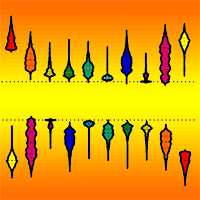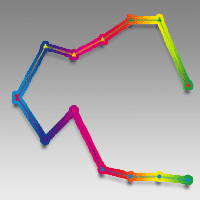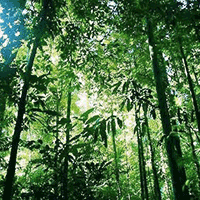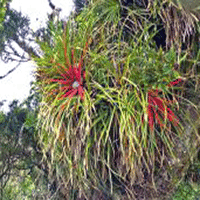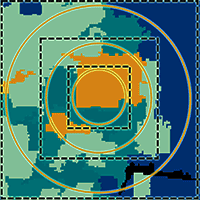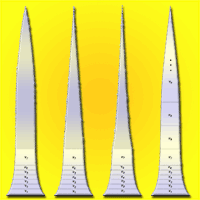The nearest neighbor trees (NNTs) are essential for reflecting forest structure and spatial heterogeneity in a forest stand. It is not clear whether different tree species have varied patterns of NNTs in a small area due to biological interactions, whether big trees affect the nearest neighbors for diversity and recruitments, or whether a universal linear relationship between the distance of NNTs and their average DBH exists. In this study, the information of NNTs at two plots (each 30 × 100 m) in a temperate mixed broadleaved forest in Southern USA was collected by field survey. Our results indicated that approximately 80% of NNTs were within a distance of 1.5-4.0 m. Tulip poplar, oaks, and hickory trees did not have the same species as NNTs or were very limited. Carolina buckthorn had itself as an NNT but with fewer other species. Sugar maple could serve as the NNT for oaks, hickory and others. The relationships between the distance of an NNT and its cumulative percentage were different among varied species or groups. Overall, for trees and their NNTs, there existed complicated relationships between their sizes (e.g., height and DBH). Big trees might affect NNTs in diversity and recruitment. The suggested linear relationship between tree size and distance was not observed. The results could be helpful to manage forest structure (tree species and NNT) and provide evidence to improve the scaling theory on NNTs.
Keywords
, , , ,
Citation
Chen X, Bowman KA (2022). The patterns of nearest neighbor trees in a temperate forest. iForest 15: 315-321. - doi: 10.3832/ifor4035-015
Academic Editor
Maurizio Marchi
Paper history
Received: Dec 09, 2021
Accepted: Jun 20, 2022
First online: Aug 23, 2022
Publication Date: Aug 31, 2022
Publication Time: 2.13 months
© SISEF - The Italian Society of Silviculture and Forest Ecology 2022
Open Access
This article is distributed under the terms of the Creative Commons Attribution-Non Commercial 4.0 International (https://creativecommons.org/licenses/by-nc/4.0/), which permits unrestricted use, distribution, and reproduction in any medium, provided you give appropriate credit to the original author(s) and the source, provide a link to the Creative Commons license, and indicate if changes were made.

Breakdown by View Type
(Waiting for server response...)
Article Usage
Total Article Views: 27625
(from publication date up to now)
Breakdown by View Type
HTML Page Views: 24368
Abstract Page Views: 1590
PDF Downloads: 1244
Citation/Reference Downloads: 3
XML Downloads: 420
Web Metrics
Days since publication: 1161
Overall contacts: 27625
Avg. contacts per week: 166.56
Article Citations
Article citations are based on data periodically collected from the Clarivate Web of Science web site
(last update: Mar 2025)
(No citations were found up to date. Please come back later)
Publication Metrics
by Dimensions ©
Articles citing this article
List of the papers citing this article based on CrossRef Cited-by.
(1)
Bianchi E, Bugmann H, Hobi ML, Bigler C (2021)Spatial patterns of living and dead small trees in subalpine Norway spruce forest reserves in Switzerland. Forest Ecology and Management 494: 119315.
CrossRef |
Gscholar
(2)
Bonan GB (1988)The size structure of theoretical plant populations: spatial patterns and neighborhood effects. Ecology 69: 1721-1730.
CrossRef |
Gscholar
(3)
Chen X, Li B-L (2003)Testing the allometric scaling relationships with seedlings of two species. Acta Oecologica 24: 125-129.
CrossRef |
Gscholar
(4)
Chen X (2006)Tree diversity, carbon storage and soil nutrient in an old-growth forest at Changbai Mountain, Northeast China. Communications in Soil Science and Plant Analysis 37: 363-375.
CrossRef |
Gscholar
(5)
Chen X (2010)Trends of forest inventory data in Alabama, USA during the last seven decades. Forestry 83: 517-526.
CrossRef |
Gscholar
(6)
Chen X (2018)Diverse scaling relationships of tree height and diameter in five tree species. Plant Ecology and Diversity 11: 147-155.
CrossRef |
Gscholar
(7)
Chen X (2020)Managing the forest landscape: exploring the quantitative interplay between forestland patches, areas and landowner numbers in counties from Alabama, USA. Small-Scale Forestry 19: 505-520.
CrossRef |
Gscholar
(8)
Chen X, Niu J (2020)Relationships between tree height and tree species richness at small scales. Acta Oecologica 109: 103668.
CrossRef |
Gscholar
(9)
Connell JH (1971)On the roles of natural enemies in preventing competitive exclusion in some marine animals and in rain forest trees. In: “Dynamics of Populations”. Center for Agricultural Publishing and Documentation, Wageningen, The Netherlands, pp. 298-312.
Gscholar
(10)
Enquist BJ, West GB, Brown JH (2009)Extensions and evaluations of a general quantitative theory of forest structure and dynamics. Proceedings of National Academy of Sciences USA 106: 7046-7051.
CrossRef |
Gscholar
(11)
Goff FG, Zedler PH (1968)Structural gradient analysis of upland forests in the western Great Lakes area. Ecological Monograph 38: 65-86.
CrossRef |
Gscholar
(12)
Goff FG, West D (1975)Canopy-understory interaction effects on forest population structure. Forest Science 21: 98-108.
Online |
Gscholar
(13)
Goodburn JM, Lorimer CG (1999)Population structure in old-growth and managed northern hardwoods: an examination of the balanced diameter distribution concept. Forest Ecology and Management 118: 11-29.
CrossRef |
Gscholar
(14)
Greig-Smith P (1982)Quantitative plant ecology (3rd edn). Blackwell, Oxford, UK, pp. 359.
Online |
Gscholar
(15)
Grubb P (1977)The maintenance of species richness in plant communities: the importance of the regeneration niche. Biological Review 53: 107-145.
CrossRef |
Gscholar
(16)
Hubbell SP (1997)A unified theory of biogeography and relative species abundance and its application to tropical rain forests and coral reefs. Coral Reefs 16: S9-S21.
CrossRef |
Gscholar
(17)
Hubbell SP (2001)The unified neutral theory of biodiversity and biogeography. Princeton University Press, Princeton, NJ, USA, pp. 392.
Gscholar
(18)
Ishihara MI, Konno Y, Umeki K, Ohno Y, Kikuzawa K (2016)A new model for size-dependent tree growth in forests. PLOS One 11: e0152219.
CrossRef |
Gscholar
(19)
Iverson LR, Prasad AM (1998)Predicting abundance of 80 tree species following climate change in the eastern United States. Ecological Monograph 68: 465-485.
CrossRef |
Gscholar
(20)
Janzen DH (1970)Herbivores and the numbers of tree species in tropical forests. American Naturalist 104: 501-528.
CrossRef |
Gscholar
(21)
King DA (1994)Influence of light level on the growth and morphology of sapling in a Panamianan forest. American Journal of Botany 81: 948-957.
CrossRef |
Gscholar
(22)
Kotliar NB, Wiens JA (1990)Multiple scales of patchiness and patch structure: a hierarchical framework for the study of heterogeneity. Oikos 59: 253-260.
CrossRef |
Gscholar
(23)
Lieberman M, Lieberman D (2007)Nearest-neighbor tree species combinations in tropical forest: the role of chance, and some consequences of high diversity. Oikos 116: 377-386.
CrossRef |
Gscholar
(24)
Li Y, Hui G, Yu S, Luo Y, Yao X, Ye S (2017)Nearest neighbour relationships in
Pinus yunnanensis var.
tenuifolia forests along the Nanpan River, China. iForest 10: 746-753.
CrossRef |
Gscholar
(25)
Liu P, Wang W, Bai Z, Guo Z, Ren W, Huang J, Xu Y, Yao J, Ding Y, Zang R (2020)Competition and facilitation co-regulate the spatial patterns of boreal tree species in Kanas of Xinjiang, northwest China. Forest Ecology and Management 467: 118167.
CrossRef |
Gscholar
(26)
McRoberts RE (2012)Estimating forest attribute parameters for small areas using nearest neighbors techniques. Forest Ecology and Management 272: 3-12.
CrossRef |
Gscholar
(27)
Moilanen A, Nieminen M (2002)Simple connectivity measures in spatial ecology. Ecology 83: 1131-1145.
CrossRef |
Gscholar
(28)
Peterken GF (1996)Natural woodland: ecology and conservation in northern temperate regions. Cambridge University Press, Cambridge, UK, pp. 522.
Online |
Gscholar
(29)
Poland TM, McCullough DG (2006)Emerald ash borer invasion of the urban forest and the threat to North America’s ash resource. Journal of Forestry 104: 118-124.
Online |
Gscholar
(30)
Pommerening A, Grabarnik P (2019)Individual-based methods in forest ecology and management. Springer, Cham, Switzerland, pp. 411.
Online |
Gscholar
(31)
Ponge J-F (2005)Emergent properties from organisms to ecosystems: towards a realistic approach. Biological Review 80: 403-411.
CrossRef |
Gscholar
(32)
Punchi-Manage R, Wiegand T, Wiegand K, Getzin S, Huth A, Gunatilleke CVS, Gunatilleke IAUN (2015)Neighborhood diversity of large trees shows independent species patterns in a mixed dipterocarp forest in Sri Lanka. Ecology 96: 1823-1834.
CrossRef |
Gscholar
(33)
Purves D, Pacala S (2008)Predictive models of forest dynamics. Science 320: 1452-1453.
CrossRef |
Gscholar
(34)
Rubin BD, Manion PD, Faber-Langendoen D (2006)Diameter distributions and structural sustainability in forests. Forest Ecology and Management 222: 427-438.
CrossRef |
Gscholar
(35)
West GB, Enquist BJ, Brown JH (2009)A general quantitative theory of forest structure and dynamics. Proceedings of National Academy of Sciences USA 106: 7040-7045.
CrossRef |
Gscholar
(36)
Wiegand T, Gunatilleke S, Gunatilleke N, Okuda T (2007a)Analyzing the spatial structure of a Sri Lankan tree species with multiple scales of clustering. Ecology 88: 3088-3102.
CrossRef |
Gscholar
(37)
Wiegand T, Gunatilleke S, Gunatilleke N (2007b)Species associations in a heterogeneous Sri Lankan Dipterocarp forest. American Naturalist 170: E77-E95.
CrossRef |
Gscholar
(38)
Wilson BT, Lister AJ, Riemann RI (2012)A nearest-neighbor imputation approach to mapping tree species over large areas using forest inventory plots and moderate resolution raster data. Forest Ecology and Management 271: 182-198.
CrossRef |
Gscholar
(39)
Wong YK, Whitmore TC (1970)On the influence of soil properties on species distribution in a Malayan lowland dipterocarp forest. Malayan Forestry 33: 42-54.
Online |
Gscholar
(40)
Yuan Z, Gazol A, Wang X, Lin F, Ye J, Bai X, Li B, Hao Z (2011)Scale specific determinants of tree diversity in an old growth temperate forest in China. Basic and Applied Ecology 12: 488-495.
CrossRef |
Gscholar
(41)
Yuan Z, Ali A, Jucker T, Ruiz-Benito P, Wang S, Jiang L, Wang X, Lin F, Ye J, Hao Z, Loreau M (2019)Multiple abiotic and biotic pathways shape biomass demographic processes in temperate forests. Ecology 100: e02650.
CrossRef |
Gscholar
(42)
Zenner EK, Peck JE (2018)Floating neighborhoods reveal contribution of individual trees to high substand scale heterogeneity. Forest Ecology and Management 412: 29-40.
CrossRef |
Gscholar




